VIBRO_1_DIRECT_simulations-ACTRAN振动声学直接频响分析理论
- 格式:pdf
- 大小:1.71 MB
- 文档页数:43
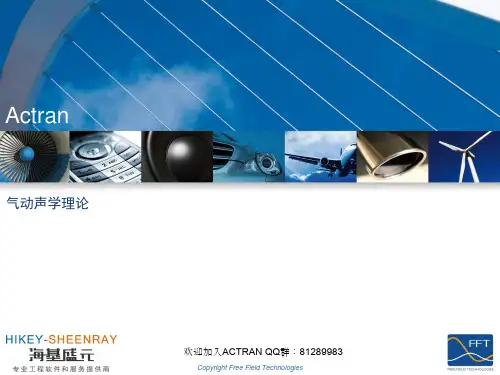

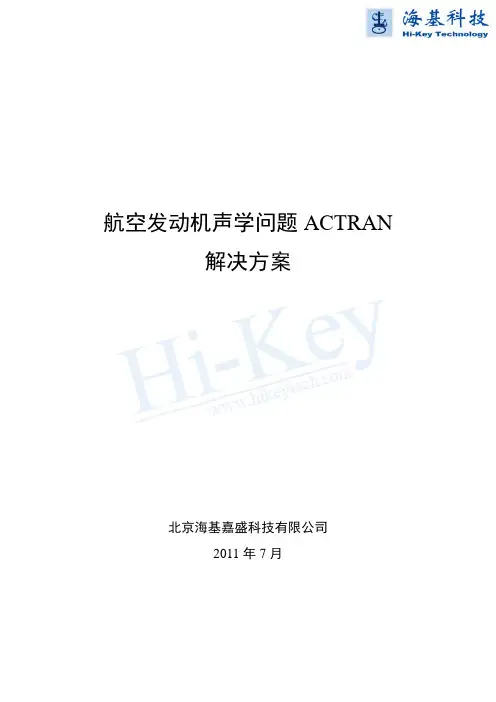
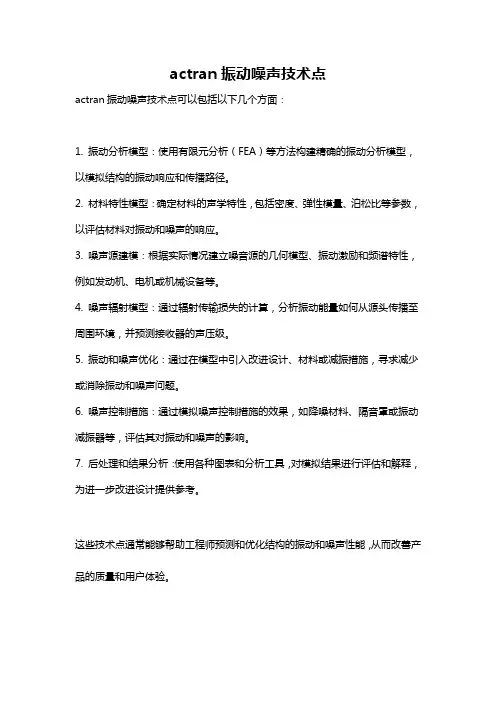
actran振动噪声技术点
actran振动噪声技术点可以包括以下几个方面:
1. 振动分析模型:使用有限元分析(FEA)等方法构建精确的振动分析模型,以模拟结构的振动响应和传播路径。
2. 材料特性模型:确定材料的声学特性,包括密度、弹性模量、泊松比等参数,以评估材料对振动和噪声的响应。
3. 噪声源建模:根据实际情况建立噪音源的几何模型、振动激励和频谱特性,例如发动机、电机或机械设备等。
4. 噪声辐射模型:通过辐射传输损失的计算,分析振动能量如何从源头传播至周围环境,并预测接收器的声压级。
5. 振动和噪声优化:通过在模型中引入改进设计、材料或减振措施,寻求减少或消除振动和噪声问题。
6. 噪声控制措施:通过模拟噪声控制措施的效果,如降噪材料、隔音罩或振动减振器等,评估其对振动和噪声的影响。
7. 后处理和结果分析:使用各种图表和分析工具,对模拟结果进行评估和解释,为进一步改进设计提供参考。
这些技术点通常能够帮助工程师预测和优化结构的振动和噪声性能,从而改善产品的质量和用户体验。
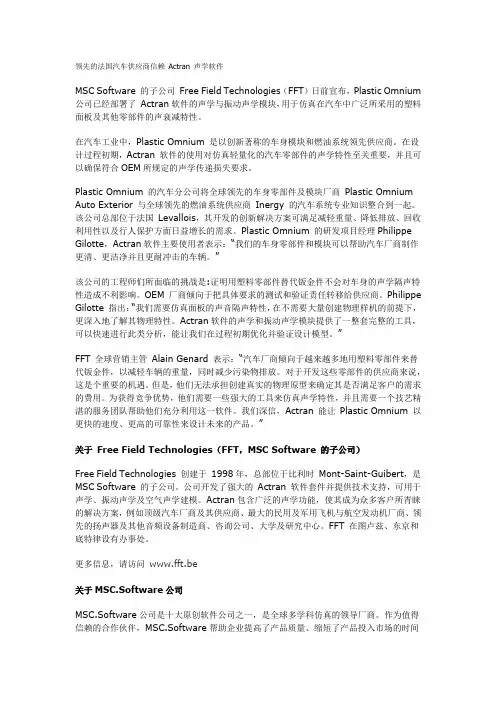
领先的法国汽车供应商信赖Actran 声学软件MSC Software 的子公司Free Field Technologies(FFT)日前宣布,Plastic Omnium 公司已经部署了Actran软件的声学与振动声学模块,用于仿真在汽车中广泛所采用的塑料面板及其他零部件的声衰减特性。
在汽车工业中,Plastic Omnium 是以创新著称的车身模块和燃油系统领先供应商。
在设计过程初期,Actran 软件的使用对仿真轻量化的汽车零部件的声学特性至关重要,并且可以确保符合OEM所规定的声学传递损失要求。
Plastic Omnium 的汽车分公司将全球领先的车身零部件及模块厂商Plastic Omnium Auto Exterior 与全球领先的燃油系统供应商Inergy 的汽车系统专业知识整合到一起。
该公司总部位于法国Levallois,其开发的创新解决方案可满足减轻重量、降低排放、回收利用性以及行人保护方面日益增长的需求。
Plastic Omnium 的研发项目经理Philippe Gilotte,Actran软件主要使用者表示:“我们的车身零部件和模块可以帮助汽车厂商制作更清、更洁净并且更耐冲击的车辆。
”该公司的工程师们所面临的挑战是:证明用塑料零部件替代钣金件不会对车身的声学隔声特性造成不利影响。
OEM 厂商倾向于把具体要求的测试和验证责任转移给供应商。
Philippe Gilotte 指出:“我们需要仿真面板的声音隔声特性,在不需要大量创建物理样机的前提下,更深入地了解其物理特性。
Actran软件的声学和振动声学模块提供了一整套完整的工具,可以快速进行此类分析,能让我们在过程初期优化并验证设计模型。
”FFT 全球营销主管Alain Genard 表示:“汽车厂商倾向于越来越多地用塑料零部件来替代钣金件,以减轻车辆的重量,同时减少污染物排放。
对于开发这些零部件的供应商来说,这是个重要的机遇。

声学仿真软件Actran新功能展示12, 09, 2018•FFT公司成立于1998年,2011年并入MSC软件公司•公司总部:比利时布鲁塞尔;•公司分部:北京,图卢兹,东京,底特律•公司业务:•Actran声学软件开发•工程咨询项目,软件技术支持,培训及方法论开发•声学CAE科研Free Field TechnologiesActran Across Industries Transport & Vehicles Aeronautics Automotive Railway Ship Building Aerospace Heavy Machinery Consumer Goods Factory Equipment Industrial Machinery Power toolsDomestic appliance Audio Consumer Electronics Hearing Aids Machinery for FactoryActran软件功能模块Actran基础声学模块Actran振动声学模块Actran气动声学模块Actran TM模块Actran for Trimmed bodyDMPActran SNGR模块ActranVIActran DGM模块目录⏹振动辐射噪声新功能⏹扬声器模拟新功能⏹虚拟统计能量法新功能⏹旋转机械气动噪声新方法⏹SNGR方法及其应用⏹DGM新功能3. Post Processing and Analysis: Actran 2. Acoustic radiation: Actran in Frequency or Time Domain1. Structural Analysis: MSC Nastran, Adams/Flex, Marc, Actran, etc.MapsStructure surfacevibrationFRF Waterfall ElementscontributionAcoustic directivity Time domain pressure Sound fileAnimation•辐射噪声仿真流程预览•声学网格生成•专业、易用的声辐射网格生成功能•方便结构工程师从零基础学习声辐射建模•更多丰富的网格生成和更改功能(1)Actran 振动辐射噪声新功能:更高的计算效率•频率自适应网格的自动生成•频率网格自适应(H-Adaptivity )•可选用声学无限元或APML 方法•建模时无需准备声学网格,大大降低模型建立难度•可通过API 进行脚本化操作,进行自动化计算流程或优化计算流程708Hz ~ 850Hz 2539Hz ~ 3047Hz……Frequency (Hz)时间节省63% 自适应网格计算时间Actran API。

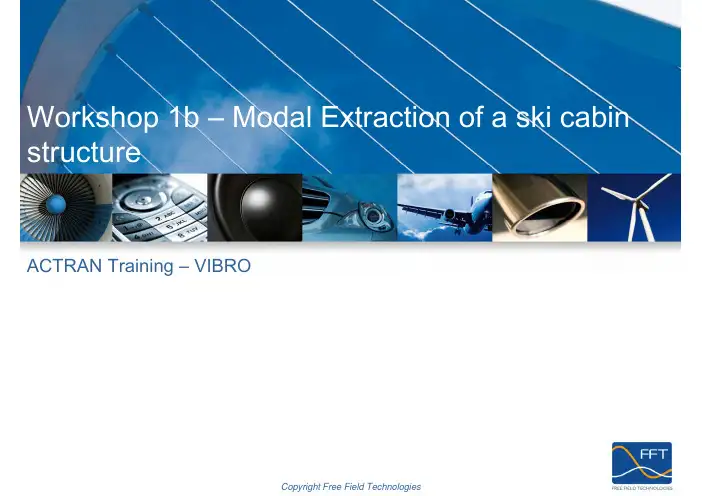
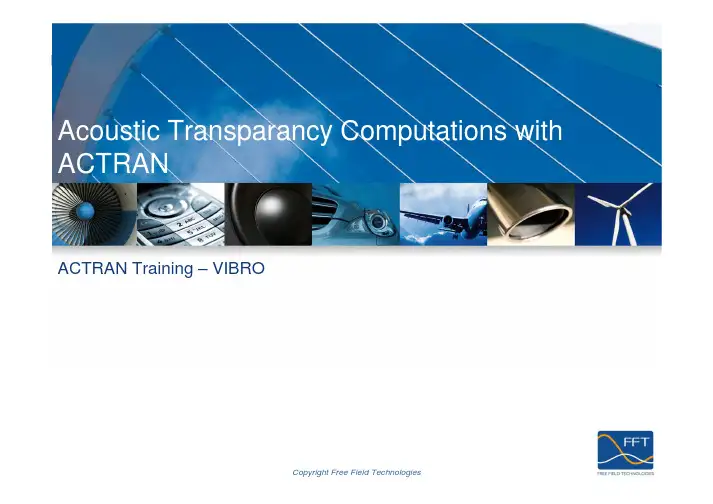
Acoustic Transparancy Computations with ACTRANACTRAN Training – VIBROCopyright Free Field TechnologiesIntroductionPre-requisites - before going through this presentation, the reader should have read and understood the following presentations:Theory ACTRAN Acoustics basic; Theory VIBRO DIRECT Simulation;These slides present the different concepts and modeling tools for computing Transmission Loss (TL) indexes in ACTRAN.2Copyright Free Field TechnologiesContentAcoustic TransparencyModeling Acoustic Transparency with ACTRANDiffuse sound fieldRayleigh surface3Copyright Free Field TechnologiesAcoustic TransparencyAcoustic transparency generally defined a group of standard tests performed to assess the ability of a component to attenuate soundThe standard tests of acoustic transparency generally involved 2 rooms acoustically connected by the system to be testedThe typical indicator used in Acoustic Transparency is the Transmission Loss index (TL)4Copyright Free Field TechnologiesWhat is the transmission loss index?Transmission loss:Symbols used in the literature: TL, STL or R expressed in dB Intrinsic property of system (does not depend on the coupled rooms of the set-up)TL = 10 ⋅ log10(1 τ )[ dB ]withτ (ω ) = Wtransmitted / WincidentThe transmission loss is the logarithmic representation of the ratio of powers: what is the part of the incident power that will be transmitted through the studied structure.5Copyright Free Field TechnologiesTypical measurement set-up: associated chambersAnechoic and reverberant rooms can be associated: side by side (classic transmission loss measurements) or on top of each other (building impact noise). Most used set-up: two side-by-side reverberant rooms 6Copyright Free Field TechnologiesTypical measurement set-up: associated reverberant chambersASTM E90 STL = SPL(source room) – SPL(receiving room) +10 log S – 10 log A(receiving room surface) [dB] S = area of test specimen (common to both rooms) A = sound absorption of receiving room with test specimen in place (metric Sabins) STL = R = TL = sound transmission loss index The sound pressure level (SPL) is measured in each rooms using a rotating microphone (pressure average). The sound absorption can be derived from reverberation time measurement7Copyright Free Field TechnologiesSimplified experimental set-upsTwo small chambers test set-up8Copyright Free Field TechnologiesSimplified experimental set-upsSmall cabin test set-up9Copyright Free Field TechnologiesContentAcoustic TransparencyModeling Acoustic Transparency with ACTRANDiffuse sound fieldRayleigh surfaces10Copyright Free Field TechnologiesReal ProblemExperimental Set up to be modeled:Anechoic Receiving Room Measurement ofIncident PowerMeasurement ofRadiated PowerReverberant Room withDiffuse Sound FieldSystem to be characterizedACTRAN Modeling Strategy (1)The Diffuse Sound Field (DSF) excitation available in ACTRAN can be used to simulated the incident sound field loading the systemThe reverberant room is not modeled. The DSF boundary condition is applied on the loaded surfaceThe incident power over the surface is automatically computedThe Rayleigh Surface component or the Infinite Fluid Component can be used to model the radiation in free fieldNo or limited modeling of the receiving roomThe power radiated by the system is automatically outputThe PLTViewer viewer has a TL operator to quickly plot the TL index from the PLT file computedACTRAN offers two different ways to model free field radiation of baffled structures :A combination of a Finite Fluidand an Infinite Fluid components The definition of aRayleigh Surface componentFinite Fluid DomainInterest of Rayleigh Surface:Reduction of the meshing effortReduced number of degrees of freedomDisadvantages of Rayleigh Surface :Limited to plane or nearly plane baffled structuresLimits of the ModelingThe acoustic field of a reverberant chamber is no longer diffuse under a cut-off frequency that depends on the room size and shapeComparison between test and simulation below the cut-off frequency should be done with careThe fixation of the system is ideal in the simulation while it may not be perfect in the realityThis may explain discrepancies between the test and simulation resultsContentAcoustic TransparencyModeling Acoustic Transparency with ACTRAN Diffuse sound fieldRayleigh surfacesThe set of a Diffuse Sound Field boundary condition is done in 2 stepsDefine the parameter of DSFSpecify the surface of application through an Incident Surface post-processing componentThe Diffuse Sound Field Boundary Condition(1)TypeInput Power Spectral Density (PSD)Properties of the reverberant roomNumber of samples simulatedThe Diffuse Sound Field Boundary ConditionDiffuse field :“Sound field in which the time average of the mean-square sound pressure is everywhere the same and the flow of acoustic energy in all directions is equally probable.”(INCE)Diffuse fields are produced experimentally by activating strong acoustic sources in a reverberant chamber, the multiple reflections along the boundary wallsleading to a “diffuse” field.Association of an Incident Surface to the DSF excitationAdd a new Incident Surface post-processing component Drag’nDrop the surface mesh of applicationDrag’nDrop the Incident Surface to the DSF excitationThe Diffuse Sound Field Boundary Condition(2)The Diffuse Sound Field –Element of Theory(1)The Diffuse Sound Field is considered as a weakly stationary random processThe DSF is characterized by the cross-correlation function betweeneach pair of loaded nodes The input of a Random excitation is given in term of Power Spectral ()rk r k f ⋅⋅=sin Density (PSD)(2)The strategy to compute the response of a system under a DSF is to: Perform a Cholesky decomposition of the DSF matrixCompute the response of the system to a large number of samplesCompute the average response to the samplesOutput PSD= Σ(Output sample)²It is advise to set at least 30 samplesThe PSD response is automatically computed when a PSD_FILENAME is provided(3)For further information about the Random excitations and their full theory, please refer to the VIBRO_RANDOM_Simulation.pdfpresentationContentAcoustic TransparencyModeling Acoustic Transparency with ACTRAN Diffuse sound fieldRayleigh surfacesRayleigh Surfaces DefinitionThe acoustic field related to a baffled plane (or nearly plane) structure can be modeled using the Rayleigh boundary integral representation :∫ρω=S n 2)y (dS )y ,x (G )y (u )x (p Rigid plane Rayleigh surface Field pointsField point can be defined to retrieve de pressure in the far field Rigid plane Vibrating plateThe Rayleigh Surface Component (2)Syntax in the ACTRAN input file: Definition in ACTRAN/VIBEGIN RAYLEIGH_SURFACE surface_idMATERIAL material_idnumber of faceList of facesEND RAYLEIGH_SURFACE surface_idDomainGoing FurtherThe concepts that have been presented are put in practice in the workshop Workshop_VIBRO_4_Windshield.pdf。
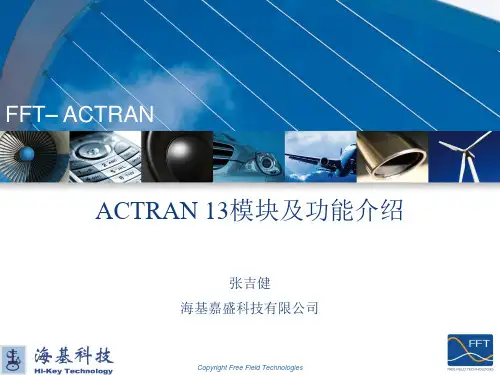
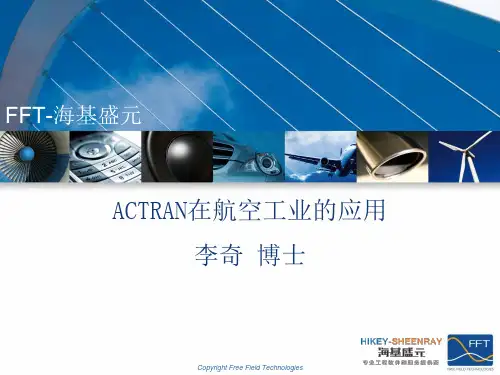
actran的仿真步骤Actran是一款广泛应用于声学仿真领域的软件工具。
它通过数值模拟和声学分析,可以帮助工程师和研究人员预测声学系统的性能和行为。
在本文中,我将详细介绍如何使用Actran进行仿真,从准备模型数据到设置模拟参数,再到分析结果。
第一步:模型准备在开始仿真之前,我们需要准备一个详细的模型。
这个模型可以是实际系统的CAD设计文件,也可以是从其他软件导出的几何模型。
Actran支持多种格式的几何文件,包括STL、IGES和STEP等。
一旦准备好几何模型,我们就可以进一步定义模型的材料属性和边界条件。
这些信息对于仿真结果的准确性和可靠性至关重要。
第二步:网格划分在模型准备阶段完成后,我们需要将模型划分为离散的网格。
这些网格将用于数值计算和仿真计算。
Actran提供了多种网格划分算法,例如,等间距网格、自适应网格和非结构网格。
选择合适的网格划分算法是保证仿真结果准确性的关键。
第三步:引入声源和接收器在完成网格划分之后,我们需要在模型中引入声源和接收器。
声源是产生声波的源头,可以是点源、线源或面源。
接收器则是用于测量声场的位置。
在Actran中,我们可以自定义声源和接收器的位置和属性,并且还可以定义多个声源和接收器,以模拟复杂的声学系统。
第四步:设置仿真参数在模型准备阶段完成后,我们需要设置仿真参数。
这些参数包括模拟的频率范围、时间范围、声场中的介质属性等。
通过调整这些参数,我们可以获得所需的模拟精度和计算效率。
此外,Actran还提供了多种高级参数设置,例如,声学辐射模式、声学材料的吸声特性等。
合理设置这些参数可以提高仿真结果的精度和可靠性。
第五步:运行仿真计算设置好仿真参数后,我们可以开始运行仿真计算了。
Actran使用声场分析方法和数值计算方法来求解声学方程。
它通过将声学系统划分为大量的小单元,然后在这些单元之间建立数学方程组,并使用迭代方法逐步求解这些方程组。
这样的迭代过程直到达到预设的收敛准则。
产品名称: LMS b模块介绍产品简介LMS b Motion多体动力学LMS b Motion多体动力学能够让设计师和工程师真实地仿真整车设计中驾驶的平顺性及操纵的稳定性,新型挖掘机的运转,或者机械开关的可靠性等。
LMS b Motion多体动力学作为先进的MBS解决方案,结合了具有自动化程序的集成仿真环境和广泛的应用领域,包括动力总成动力学、悬架动力学、履带动力学等。
此外,仿真结果还可以用于后续的与耐久性或者噪声振动分析相关的研究,例如高精度求解器预测的覆盖整个频率范围的动态内部载荷。
•LMS b Standard Motion 标准动力学软件LMS b Standard Motion是一个对机械系统真实运动和载荷进行仿真的完整集成解决方案。
它能使工程师在进行昂贵的实物样机试验前快速地分析和优化机械设计的真实性能,并能保证机构具有预期功能。
LMS b Standard Motion使用户能够建立和模拟多刚体机械系统,改进它们的动力学性能,预测部件和系统的载荷,以便用于结构分析、振动噪声模拟、疲劳寿命预测和其它分析。
LMS b Standard Motion在实体建模、参数化、CAD几何体、柔性体特点、控制和液压功能、求解器性能、动画显示和后处理功能等方面提供了极具前沿的领先技术。
它独创地把所有需要的功能集成到一个用户界面友好的桌面环境,不需要其它求解器,并消除了费时的数据转换。
采用LMS b Standard Motion,用户可以利用一个基于CATIA V5的完全集成的CAD引擎,快速地创建和改进他们的机械系统的虚拟样机模型。
实体建模器可以得到一个完整的参数化模型。
机械单元包括弹簧、摩擦力、接触力和广泛的运动副和约束功能。
稳定和高性能的求解器对即使是最复杂的动力学问题都能保证精确和高效的处理。
数据结果中包括位移、速度、加速度和模型所有部件的相互作用力。
专门的动画显示和后处理特点可以帮助工程师轻松地识别并有效地解决某个工程问题的根本原因。
Vibro-Acoustic SimulationsACTRAN Training – VIBROCopyright Free Field TechnologiesIntroductionPre-requisites - before going through this presentation, the reader should have read and understood the following presentations:1_BASICS_General_Program_Organization.pdf; Workshop_BASICS_0_Edit_an_ACTRAN_input_file.pdf.These slides present the basics materials, components and boundary conditions involved in a structural simulation in physical coordinates.2Copyright Free Field TechnologiesContentThe structural MaterialsThe visco-elastic and shell ComponentThe equivalent beam Component and MaterialThe discrete Component and MaterialThe Boundary ConditionsMeshing Criteria3Copyright Free Field TechnologiesStructural MaterialsThe solid materials are used for describing both viscous and non viscous solids with and without different structural properties along the different axisThree different types solid materials are available:Isotropic solid material Transverse isotropic solid material Orthotropic materialComposite materials can also be defined to model the different layers of a solid material using a homogenization option – See dedicated presentation4Copyright Free Field TechnologiesThe Isotropic Solid Material (1)Isotropic materials are materials whose mechanical properties are uniform along all directionsThe properties that define an Isotropic solid material can be given using 2 set of parameters:Young modulus (E) Poisson ratio (ν) Solid density or First (λ) Lamé’s coefficient and Second (µ or G, the shear modulus) Lamé’s coefficient Solid densityAll parameters are mandatory5Copyright Free Field TechnologiesThe Isotropic Solid Material (2)Syntax in the ACTRAN input file:BEGIN MATERIAL Id ISOTROPIC_SOLID YOUNG_MODULUS value POISSON_RATIO value SOLID_DENSITY value END MATERIAL IdOrDefinition in ACTRAN/VIBEGIN MATERIAL Id ISOTROPIC_SOLID LAME1 value LAME2 value SOLID_DENSITY value END MATERIAL Id6Copyright Free Field TechnologiesThe Transverse Isotropic Solid Material (1)Transverse isotropic materials are materials whose mechanical properties are symmetric about an axis that is normal to a plane of isotropy.Unidirectional fiber composite lamina; Honeycomb components, …The properties that define a transverse isotropic solid material are:5 mechanical properties En, νn, Et, νt and G; Solid density Axis of isotropy, oriented along the fibers3 2 1 7Copyright Free Field TechnologiesThe Transverse Isotropic Solid Material (2)Their mechanical properties can be divided in different parts:Young modulus (En) and Poisson ratio (νn) when sujected to normal (along the isotropy axis) load (also named normal_E and normal_ν) Young modulus (Et) and Poisson ratio (νt) when sujected to transverse (along the isotropy plane) load (also named inplane_E and inplane_ν) Shear modulus (G) characterizing inplane shear deformations due to shear loads The isotropy axis defining the direction of the fiber in the local coordinate system8Copyright Free Field TechnologiesThe Transverse Isotropic Solid Material (3)Syntax in the ACTRAN input file: Definition in ACTRAN/VIBEGIN MATERIAL Id TRANSVERSE_ISOTROPIC_SOLID NORMAL_E_MODULUS value INPLANE_E_MODULUS value NORMAL_POISSON_RATIO value INPLANE_POISSON_RATIO value NORMAL_S_MODULUS value ISOTROPIC_AXIS value SOLID_DENSITY value END MATERIAL Id9Copyright Free Field TechnologiesThe Orthotropic Solid Material (1)Orthotropic materials are materials whose mechanical properties are different in all directions:Honeycomb components; Wood,…The properties that define an orthotropic solid material are:9 Mechanical properties E1, E2, E3, ν12, ν13, ν23, G12, G13, G23; Solid density10Copyright Free Field TechnologiesE i corresponds to the Young modulus inthe direction i expressed in the local coordinate systemG ij corresponds to the shear modulus indirection i for which the shear load relies on the plane whose normal is in direction x 2x 3x 1x 2x 3SNN/E 1-ν12 N/E 1-ν12 N/E 1j in the local coordinate system (G ij =G ji ) νij is the Poisson ratio that corresponds toa contraction in direction j when an extension is applied in direction IThe local coordinate system is defined bythe element and the component that refers to an orthotropic materialx 1S/G 13S/G 13SS/G 23S/G 23x 1x 2x 3Syntax in the ACTRAN input file: Definition in ACTRAN/VI BEGIN MATERIAL IdORTHOTROPIC_SOLIDYOUNG_1 valueYOUNG_2 valueYOUNG_3 valuePOISSON_12 valuePOISSON_13 valuePOISSON_23 valueSHEAR_12 valueSHEAR_13 valueSHEAR_23 valueSOLID_DENSITY valueEND MATERIAL IdDamping ModelAll properties in ACTRAN are defined using complex numbersDamping can be introduced using a complex Young modulus:withE’ the Young modulus, image of the stiffness"'jE E E +=E” the Loss modulus, representing internal lossesThe loss modulus is linked to the internal loss factor η(also called tg(δ)) by:()ηj E jE E E +⋅=+=1'"'ContentThe structural MaterialsThe visco-elastic and shell ComponentsThe equivalent beam Component and Material The discrete Component and MaterialThe Boundary ConditionsMeshing CriteriaThe Solid component is the standardSupported topologies component for modeling visco-elastic solid parts.Points to a valid Isotropic solid materialUnknowns: solid displacement in each direction –3 dofs per node (no rotation)Syntax in the ACTRAN input file:Definition in ACTRAN/VIBEGIN COMPONENT IdSOLIDMATERIAL material_id [POWER_EVALUATION 1][INCOMPRESSIBLE 1]END COMPONENT IdPOWER_EVALUATION 1 activatesthe computation of the dissipated power in the component (optional) INCOMPRESSIBLE 1 allows to modelvisco-elastic parts with a Poisson ratio close to 0.5 (optional -check the ACTRAN Users’ Manual for more information)Choose “Solid” as typeDomainThe solid shell component is used to modelSupported topologies transverse solid element, with a thicknessdirectionOne dimension of the structure should be smallcompared to the 2 others (roughly 1/15)Thickness (and thus compression effects) areaccounted for using solid shellsIts formulation converges faster for thin structuresthan a solid componentCan point to all solid materials (isotropic,transverse isotropic, orthotropic, composite)Unknowns: solid displacement in each direction –3 dofs per node (no rotation)Syntax in the ACTRAN input file:POWER_EVALUATION 1 activates theDefinition in ACTRAN/VIBEGIN COMPONENT IdSHELL [AUTO_ORIENT]MATERIAL material_id [POWER_EVALUATION 1][REFERENCE_DIRECTION 1 0 0]END COMPONENT Idcomputation of the dissipated power in the component (optional) REFERENCE_DIRECTION allows toorient the local material coordinate system for non isotropic solid materials (default 1,0,0) AUTO_ORIENT keyword allows toautomatically reorient the transverse direction of the elementsChoose “Solid Shell” as typeDomainShell elements’ orientation is an important parameter (transverse direction)The transverse direction is dependent of the order of the nodes in the element description (input file, MESH > ELEMENT) :BEGIN ELEMENT ...212 12 112 13 14 15 27 28 29 30...END ELEMENTLower nodes Upper Nodes1213141527282930Meshes obtained by normal extrusion or normal sweeping lead to a correct numbering (lower nodes then upper nodes)Automatic detection is possible using the keyword AUTO_ORIENT .This remark is valid for all transverse elements: Solid Shell, ViscothermalAUTO_ORIENT should automatically detect the transverse direction of theshell elementDimensions close to be the same…hazardous AUTO_ORIENTThe Thin Shell Component (1)The thin shell component is used to model transverse thin elementOne dimension of the structure should be small compared to the 2 others (roughly 1/15) Thickness specification is mandatory Formulation is similar to the NASTRAN CQUADR and TRIAR Supported topologies31 243Can point to all solid materials (isotropic, transverse isotropic, orthotropic, composite)1 2Unknowns: solid displacement and rotation in each direction – 6dofs per nodeRemark: only linear elements are supported21Copyright Free Field TechnologiesThe Thin Shell Component (2)Syntax in the ACTRAN input file:BEGIN COMPONENT Id DSHELL MATERIAL material_id THICKNESS thickness [OFFSET offset] [POWER_EVALUATION 1] [LUMPED_MASS 0,1,2] [REFERENCE_DIRECTION 1 0 0] END COMPONENT IdDefinition in ACTRAN/VITHICKNESS value is mandatory, while the OFFSET can be optional POWER_EVALUATION 1 activates the computation of the dissipated power in the component (optional) REFERENCE_DIRECTION allows orienting the local material coordinate system for non isotropic solid materials (default 1,0,0)22Copyright Free Field TechnologiesDomainChoose “Thin Shell” as typeLumped Mass FormulationThe lumped mass formulation is a simplified formulation:Mass matrix only contains diagonal translational components (no rotational components) This formulation should decrease the computation time, but should converge slower than the standard formulation (this is not always true)The Lumped Mass formulation is NOT selected by default (different from NASTRAN)23Copyright Free Field TechnologiesSolid Shell Elements: Application(Glaverbel/Splintex)Glass layersPVB layer PVB24Copyright Free Field TechnologiesContentThe structural MaterialsThe visco-elastic and shell ComponentThe equivalent beam Component and MaterialThe discrete Component and MaterialThe Boundary ConditionsMeshing Criteria25Copyright Free Field TechnologiesThe Beam Material (1)Beam_inertia materials are used to define equivalent stiffeners mechanical properties using inertia indicators Inertia indicators can usually be retrieved in external tools or from analytical solutionsThe following properties are needed:The solid density and area of the beam cross-section The elongation modulus represent the stiffness in the z’-axis The inertia XX corresponds to the inertia with respect to the rotation around the y’ axis (=I1 in Nastran) The inertia YY corresponds to the inertia with respect to the rotation around the x’ axis (=I2 in Nastran) The inertia XY corresponds to the product inertia The inertia Z corresponds to the torsionnal inertia The cg offset values represent the position of the center of gravity (neutral axis) within the local coordinate system (default = 0) The shear offset values represent the position of the shear center within the local coordinate system (default = 0) The shear factor values represent shear stiffness factors K in K*A*G. They adjust in this way the effective transverse shear cross-section area (default = 1)Offsets and inertia are oriented within the local coordinate system of the beam element26Copyright Free Field TechnologiesThe Beam Material (2)Syntax in the ACTRAN input file:BEGIN MATERIAL material_id BEAM_INERTIA ELONGATION_MODULUS value SHEAR_MODULUS value SOLID_DENSITY value AREA value INERTIA_XX value INERTIA_XY value INERTIA_YY value CG_OFFSET_X value CG_OFFSET_Y value SHEAR_FACTOR_X value SHEAR_FACTOR_Y value SHEAR_OFFSET_X value SHEAR_OFFSET_Y value INERTIA_Z value END MATERIAL material_idDefinition in ACTRAN/VI27Copyright Free Field TechnologiesThe Beam Component (1)The Beam component is used to model equivalent stiffeners on thin elementsFormulation is similar to the NASTRAN CBEAM The component allows orienting spatially a specific beam type Supported topologiesVrefCan only point to a beam_inertia materialX’Z’Unknowns: solid displacement and rotation in each direction – 6dofs per nodeRemark: only linear elements are supportedY’28Copyright Free Field TechnologiesThe Beam Component (2)Syntax in the ACTRAN input file:BEGIN COMPONENT Id BEAM MATERIAL id [REFERENCE_DIRECTION cx cy cz] [POINT_REF 1] [POWER_EVALUATION 1] END COMPONENT IdDefinition in ACTRAN/VIcx, cy and cz are defining a reference vector which defines the local x axis Point ref to one allows to define the local system by specifying the coordinates of a point (in vref) The local element coordinate system (x’,y’,z’) is defined as follows:axis z’ is defined by the two nodes on which the beam is constructed; axes x’ and y’ are defining a plane normal to axis z’ axes x’ is defined by the projection of the reference vector on this plane; axis y’ is computed in such a way that (x’,y’,z’) form a direct orthonormal system By default, without definition of vref, the normal to the shell element is taken as the x’ axisDomain29Copyright Free Field TechnologiesContentThe structural MaterialsThe visco-elastic and shell ComponentThe equivalent beam Component and MaterialThe discrete Component and MaterialThe Boundary ConditionsMeshing Criteria30Copyright Free Field TechnologiesSpring material is the standard material for specifying stiffnesses and masses associated to node-to-ground springs, node-to-node springs or lumped masses (described by a discrete component)A free combination of stiffnesses and masses can be specified:Either in absolute coordinates (along X, Y and Z);Or in local coordinates (transverse and normal directionSyntax in the ACTRAN input file: Definition in ACTRAN/VI BEGIN MATERIAL material_idSPRINGeither[NORMAL_STIFFNESS stiff_n][TRANSVERSE_STIFFNESS stiff_t]or[X_STIFFNESS stiff_x][Y_STIFFNESS stiff_y][Z_STIFFNESS stiff_z]end eithereither[NORMAL_MASS mass_n][TRANSVERSE_MASS mass_t]or[X_MASS mass_x][Y_MASS mass_y][Z_MASS mass_z]end eitherEND MATERIAL material_idThe Discrete component is used to model node-to-ground or node-to-node springs. Additionally,they may also be used to model lumped massesThe behavior depend on the element type (1D or 0D) and the material properties Supported topologies **ttNode-to-ground (point)Syntax in the ACTRAN input file:cx , cy and cz are defining theDefinition in ACTRAN/VIBEGIN COMPONENT IdDISCRETEREFERENCE_DIRECTION cx cy cz [POWER_EVALUATION 1]END COMPONENT Idnormal direction if not straightforward (on an edge) POWER_EVALUATION 1activatesthe computation of the dissipated power in the component (optional)DomainContentThe structural MaterialsThe visco-elastic and shell ComponentThe equivalent beam Component and Material The discrete Component and MaterialThe Boundary ConditionsMeshing CriteriaBoundary ConditionsDeterministic boundary conditions :Displacement based boundary-conditionsRotational based boundary conditionsPoint, distributed and mechanical pressure loadStochastic boundary conditions (see dedicated presentation): Diffuse sound fieldTurbulent boundary layerDelta correlated (Rain on the roof)Deterministic Boundary ConditionsDisplacement :BEGIN DISPLACEMENTNumber of fixed nodesNode number, displacement component values or FREE END DISPLACEMENTRotation :BEGIN ROTATIONNumber of fixed nodesNode number, rotation component values or FREEEND ROTATION Point load :BEGIN POINT_LOADNumber of loaded nodesNode number, load component valuesEND POINT_LOADPoint moment :BEGIN POINT_MOMENTNumber of loaded nodesNode number, load component valuesEND POINT_MOMENTDistributed load :BEGIN DISTRIBUTED_LOADNumber of loaded facesFace definition, distributed load component valuesEND DISTRIBUTED_LOADPressure load :BEGIN DISTRIBUTED_PRESSURENumber of loaded facesFace definition, distributed pressure valuesEND DISTRIBUTED_PRESSUREStructural Boundary ConditionsSolid elements:Degrees of freedom ACTRAN = displacement in 3 directions (3 dofs/node) Default: free displacementThin elements:Additionally 3 rotational dofs (Default: free rotation)Ideal cases:clampedsimply supportedSolid shellThin shellConstrained displacement Constrained rotationContentThe structural MaterialsThe visco-elastic and shell ComponentThe equivalent beam Component and Material The discrete Component and MaterialThe Boundary ConditionsMeshing CriteriaFluid / Structure CouplingThe structural and acoustic components can be coupled to perform vibro-acoustic simulations. Three configurations are possible.Weak coupling where no retro-action of the fluid on the structure is taken into account Acoustic and structures model are 2 decoupled problems. Theacoustic model is excited from the structural results. The BC_MESH feature is used (see dedicated presentation).Strong coupling. The retro-action of the fluid is taken into account and the acoustic and structure components are in the same model. The acoustic and structure components can have compatible or incompatible meshes.In case of compatible meshes (the nodes at the interface are shared) the coupling is automatically detected by ACTRAN and taken into accountIn case of incompatible meshes the coupling must be specified by the user through an INTERFACE data block (see dedicated presentation).Output QuantitiesThe main quantities that can be output on structural components are: Local quantities (at field points or storage node)•The solid rotation (vector) codes srx,sry,srz•The solid displacement (vector) codes sux,suy,suzGlobal quantities (on domains) :•Length (scalar) code lgt•Mean Square Solid Velocity (scalar) code mv•Mean Square Solid Normal Velocity (scalar) code mnv•Mass (scalar) code mass•Squared Solid Normal Velocity (scalar) code snv•Squared Solid Velocity (scalar) code sv•Volume (scalar) code vol•Surface (scalar) code srfMeshing CriteriaAcoustic: Determine the acoustic wavelength as the ratio of the sound speed by the frequency Apply the following rule: use a minimum of • 6 linear elements per wavelength • 4 quadratic elements per wavelength The higher the frequency, the smaller the wavelength, the smaller the max min 44f c h ==λGoing FurtherThe concepts that have been presented are put in practice in the workshop Workshop_VIBRO_1a_Direct_Freq_Res.pdfThe different vibro-acoustic couplings methods are introduced in VIBRO_2_Fluid_Structure_Coupling.pdf。